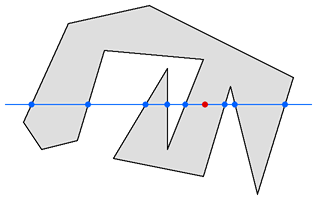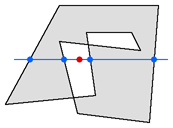point in polygon algorithm
Point-In-Polygon Algorithm — Determining Whether A Point Is Inside A Complex Polygon
© 1998,2006,2007 Darel Rex Finley. This complete article, unmodified, may be freely
distributed for educational purposes.
Visit the new page which adds spline curves to this
technique! Also visit the shortest-path-through-polygon
page!
 Figure 1
Figure 1
Figure 1 demonstrates a typical case of a severely concave polygon with 14 sides. The red dot is a point which
needs to be tested, to determine if it lies inside the polygon.
The solution is to compare each side of the polygon to the Y (vertical) coordinate of the test point, and compile a list
of nodes, where each node is a point where one side crosses the Y threshold of the test point. In this example,
eight sides of the polygon cross the Y threshold, while the other six sides do not. Then, if there are an
odd number of nodes on each side of the test point, then it is inside the polygon; if there are an even
number of nodes on each side of the test point, then it is outside the polygon. In our example, there are five
nodes to the left of the test point, and three nodes to the right. Since five and three are odd numbers, our test
point is inside the polygon.
(Note: This algorithm does not care whether the polygon is traced in clockwise or counterclockwise
fashion.)
 Figure 2
Figure 2
Figure 2 shows what happens if the polygon crosses itself. In this example, a ten-sided polygon has lines which
cross each other. The effect is much like “exclusive or,” or XOR as it is known to assembly-language
programmers. The portions of the polygon which overlap cancel each other out. So, the test point is outside
the polygon, as indicated by the even number of nodes (two and two) on either side of it.
 Figure 3
Figure 3
In Figure 3, the six-sided polygon does not overlap itself, but it does have lines that cross. This is not a
problem; the algorithm still works fine.
 Figure 4
Figure 4
Figure 4 demonstrates the problem that results when a vertex of the polygon falls directly on the Y threshold.
Since sides a and b both touch the threshold, should they both generate a node? No, because then
there would be two nodes on each side of the test point and so the test would say it was outside of the polygon, when it
clearly is not!
The solution to this situation is simple. Points which are exactly on the Y threshold must be considered to belong
to one side of the threshold. Let’s say we arbitrarily decide that points on the Y threshold will belong to the
“above” side of the threshold. Then, side a generates a node, since it has one endpoint below the
threshold and its other endpoint on-or-above the threshold. Side b does not generate a node, because both of
its endpoints are on-or-above the threshold, so it is not considered to be a threshold-crossing side.
 Figure 5
Figure 5
Figure 5 shows the case of a polygon in which one of its sides lies entirely on the threshold. Simply follow the
rule as described concerning Figure 4. Side c generates a node, because it has one endpoint below the
threshold, and its other endpoint on-or-above the threshold. Side d does not generate a node, because it has
both endpoints on-or-above the threshold. And side e also does not generate a node, because it has both
endpoints on-or-above the threshold.
 Figure 6
Figure 6
Figure 6 illustrates a special case brought to my attention by John David Munch of Cal Poly. One interior angle of
the polygon just touches the Y-threshold of the test point. This is OK. In the upper picture, only one side
(hilited in red) generates a node to the left of the test point, and in the bottom example, three sides do. Either
way, the number is odd, and the test point will be deemed inside the polygon.
Polygon Edge
If the test point is on the border of the polygon, this algorithm will deliver unpredictable results; i.e. the result may
be “inside” or “outside” depending on arbitrary factors such as how the polygon is oriented with
respect to the coordinate system. (That is not generally a problem, since the edge of the polygon is infinitely
thin anyway, and points that fall right on the edge can go either way without hurting the look of the polygon.)
C Code Sample
// Globals which should be set before calling this function:
|
Here’s an efficiency improvement provided by Nathan Mercer. The blue
code eliminates calculations on sides that are entirely to the right of
the test point. Though this might be occasionally slower for some
polygons, it is probably faster for most.
// Globals which should be set before calling this function:
|
Here’s another efficiency improvement provided by Lascha Lagidse. The
inner “if” statement is eliminated and replaced with an exclusive-OR
operation.
// Globals which should be set before calling this function:
|
And here’s a pre-calcuation efficiency improvement provided by Patrick
Mullen. This is useful if you have many points that need to be tested
against the same (static) polygon:
// Globals which should be set before calling these functions:
|
Integer Issue
What if you’re trying to make a polygon like the blue one below (Figure
7), but it comes out all horizontal and vertical lines, like the red
one? That indicates that you have defined some of your variables as
integers instead of floating-point. Check your code carefully to ensure
that your test point and all the corners of your polygon are defined
as, and passed as, floating-point numbers.
 Figure 7
Figure 7
Send me an e-mail!
| Does the brace style in the above code sample freak you out? Click here to see it explained in a new window. |
| Quicksort | Point in polygon | Mouseover menus | Gyroscope | Osmosis | Polarizer experiment | Gravity table equilibrium | Calculus without calculus | Overlapping maze |




